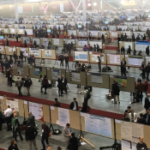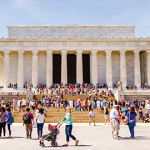
A few months ago as the 70th ACR Annual Scientific Meeting came to a close, I found myself looking back to 1975. Here are some highlights from that year:
- The National Arthritis Act established a National Commission on Arthritis and Related Musculoskeletal Diseases (NIAMDD); authorized $2 million to develop a long-range plan involving research, training, services, and data systems; established an associate director for arthritis in NIAMDD; and provided three-year authorizations for arthritis screening, detection, prevention, and referral projects and for arthritis research and demonstration centers;
- One Flew Over the Cuckoo’s Nest received an Oscar for best picture;
- “Love Will Keep Us Together,” by Captain and Tennille received a Grammy for best record of the year; and
- I attended my first ACR annual meeting in New Orleans.
That’s right, my first ACR annual meeting was the 39th annual meeting of the American Rheumatism Association Section of the Arthritis Foundation, held in New Orleans in June 1975. About 2,000 individuals attended, and it was held in a hotel—not a convention center, a hotel! At this three-day meeting in 1975, attendees had access to 306 abstracts, four plenary sessions, 12 concurrent sessions, and two workshops. In lieu of an opening reception, attendees were treated to a harbor cruise and Creole supper aboard a Mississippi river boat. I was a fellow-in-training at the University of Pittsburgh, and my best memories of that meeting are of the time we spent with my chief and then–ACR first vice president and president-elect, Gerald Rodnan, MD, sampling the oyster dishes at Mosca’s Restaurant.
Over 30 Years of Growth
It’s now 32 years later. I attended the 2006 annual meeting as ACR president-elect, and how this meeting has changed! Not just in numbers of attendees (more than 13,000) or in the number of abstracts presented (holding steady at more than 2,000), but in the evolution of the kinds of programs in which attendees can participate. The addition of clinical symposia, the vast number of meet-the-professor and workshop sessions, updates in internal medicine topics, the Year in Review literature discussion, and so much more have turned ours into a meeting that serves the needs of all our members.
Being at the meeting is an experience in itself. Nowhere else in the world do you have the opportunity to attend a variety of outstanding educational sessions, compare experiences with colleagues from more than 80 countries, and witness provocative exchanges between individuals, and celebrated scientific experts.
In 2006 it was possible for attendees to see a coherent review of the year’s clinical and basic science publications, view hundreds of posters, learn correct billing procedures, have lunch with an esteemed professor, hear presentations from the leadership of NIAMS and NIH, participate in a presentation related to the emerging approaches in the pharmacologic management of hyperuricemia and gout, listen to experts discuss the controversies in the management of antiphospholipid syndrome patients, gain practical training during a musculoskeletal ultrasonography workshop, and network with like-minded colleagues during a study group session—all on the same day.
Busy Holiday for Meeting Planers
Planning such a comprehensive annual meeting that encompasses so much is no small feat. It is both humbling and exhilarating to participate in the planning process. Last month, I was privileged to participate. More than 50 ACR volunteers representing the varying needs and constituents of the ACR membership came prepared to develop and schedule more than 200 educational sessions and reach a consensus on approximately 400 speakers.
Prior to arriving in Atlanta the majority of the volunteers had already invested at least 10 to 20 hours in the planning process. Each volunteer had reviewed the suggestions received through the formal call-for-proposals process, read each comment submitted on the 2006 meeting evaluation, scanned numerous literature reviews, and gathered data on legislative and regulatory changes. It quickly became apparent that this group of volunteers took their charge and the proposals from the membership seriously; they did not deviate from their task.
As the committee systematically worked through each proposal, some were accepted without modifications, others were grouped to complement each other, and still others were held for consideration in 2008. If a topic had been discussed at a recent meeting, or no new information was available, or no needs assessment to support the proposal was apparent, the committee eliminated the suggestion. The entire process was extremely intense and involved hours of debate and negotiation. Miraculously, within 15 hours these remarkable volunteers had planned an innovative meeting.
Without a doubt each volunteer will spend countless additional hours in the upcoming months confirming speakers and refining topics. Knowing how much effort each planning committee volunteer puts forth, I was compelled to ask several of them individually what motivated them to dedicate so much effort and time to the annual meeting. Each gave the same unassuming answer: for the opportunity to work and learn from the experts and for the satisfaction of knowing that they are part of something extraordinary.
Attendees of the 2007 ACR Annual Scientific Meeting will find much that is familiar, but this year’s meeting will also include a few surprises.
Join Us in Boston in November
When you consider the exchange of information that will take place and the topics we will discuss during the 2007 annual meeting, you realize that the educational component of the meeting will have effects for years to come as new information and treatments find their way to patients. That is definitely inspiring and extraordinary.
Attendees of the 2007 ACR Annual Scientific Meeting will find much that is familiar, but also a few surprises, like the introduction of a case-based clinical symposium scheduled opposite a plenary session to provide more variety and options for clinicians, and improved electronic syllabi. These are just two examples of the thought that has gone into redesigning the meeting to match the needs of the rheumatology community.
I would like to thank the 2007 planning committee volunteers for their dedication and enthusiasm, particularly Brian Mandell, MD, who led the process. It would be remiss of me not to acknowledge Richard Furie, MD, who led the planning process from 2004 to 2006. Dr. Furie set a high bar of achievement and excellence. See the box at left for the entire list of 2007 annual meeting planning committee members.
If you have not attended an ACR annual meeting recently, I encourage you join us in Boston this November. You will find sessions and colleagues who will challenge and impress you. If you have attended every meeting in the last 20 years, I guarantee that the 2007 annual meeting will surpass your expectations.
I look forward to seeing you in Boston.
Dr. Birnbaum is president of ACR. Contact him via e-mail at [email protected].


